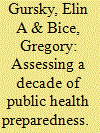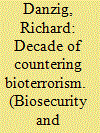|
|
|
Sort Order |
|
|
|
Items / Page
|
|
|
|
|
|
|
| Srl | Item |
| 1 |
ID:
126175


|
|
|
|
|
| Publication |
2012.
|
| Summary/Abstract |
September 11 and the subsequent anthrax attacks marked the beginning of significant investment by the federal government to develop a national public health emergency response capability. Recognizing the importance of the public health sector's contribution to the burgeoning homeland security enterprise, this investment was intended to convey a "dual benefit" by strengthening the overall public health infrastructure while building preparedness capabilities. In many instances, federal funds were used successfully for preparedness activities. For example, electronic health information networks, a Strategic National Stockpile, and increased interagency cooperation have all contributed to creating a more robust and prepared enterprise. Additionally, the knowledge of rarely seen or forgotten pathogens has been regenerated through newly established public health learning consortia, which, too, have strengthened relationships between the practice and academic communities. Balancing traditional public health roles with new preparedness responsibilities heightened public health's visibility, but it also presented significant complexities, including expanded lines of reporting and unremitting inflows of new guidance documents. Currently, a rapidly diminishing public health infrastructure at the state and local levels as a result of federal budget cuts and a poor economy serve as significant barriers to sustaining these nascent federal public health preparedness efforts. Sustaining these improvements will require enhanced coordination, collaboration, and planning across the homeland security enterprise; an infusion of innovation and leadership; and sustained transformative investment for governmental public health.
|
|
|
|
|
|
|
|
|
|
|
|
|
|
|
|
| 2 |
ID:
126005


|
|
|
|
|
| Publication |
2012.
|
| Summary/Abstract |
Rapid public health response to a large-scale anthrax attack would reduce overall morbidity and mortality. However there is uncertainty about the optimal cost effective response strategy based on timing of intervention, public health, resources, and critical care facilities. We connected a decision analytic study to compare response strategies to a theoretical large scale anthrax attack on the Chicago metropolitan area beginning either Day 2 or Day 5 after the attack. These strategies correspond to the policy option set forth by the Anthrax Modeling Working Group for population-wide response to a large scale anthrax attack: (1) postattack antibiotic prophylaxix, (2) postattack antibiotic prophylaxis and vaccination, (3) Preattack vaccination with postattack antibiotic prophylaxis, and (4) preattack vaccination with postattack antibiotic prophylaxis and vaccination.
|
|
|
|
|
|
|
|
|
|
|
|
|
|
|
|
| 3 |
ID:
126164


|
|
|
|
|
| Publication |
2012.
|
| Summary/Abstract |
The fear and disruption caused by the 2001 anthrax attacks understandably led Americans to seek enhanced biodefenses. However, the path followed since those attacks has left the country inadequately prepared to face further risks from biological attacks. Why has security against these threats been only partially achieved? This article suggests that our responses over the past decade can be sorted into 4 levels in order of increasing difficulty. First, we rapidly appropriated funds, augmented personnel, and mandated reorganization of agencies. Though not easy to accomplish, these steps were easily conceptualized and, whatever their imperfections, could rather assuredly be achieved. A second level was more demanding, but also quite achievable. It involved the amplification of ongoing efforts. These efforts sometimes suffered as they scaled up, but, though they were qualified by delays and uncertainties, we can point to real achievements at this level. A third level was more difficult: It required evolving new strategies to deal with this largely unprecedented problem. In this regard, we have so far had only glimmers of possibility. At a fourth level, our performance and our prospects are worse still. At this level, our problems stem from resistances inherent in our country's cultural and political framework. This article identifies some of these problems and suggests, regrettably, that they are not likely to be resolved until change is catalyzed by further, and more dramatically traumatic, attacks or natural disasters. If this situational assessment is correct, what remedial strategies should we pursue? The article distinguishes 3 strategic approaches: an evolutionary one in which the U.S. continues advancing along its present path; a radical approach that attempts to address the fourth-level issues; and a third approach that prepares for punctuated evolution. This third approach accepts the improbability of level 4 change either by gradual evolution or by radical argument, but asserts that it is possible to lay the conceptual groundwork now for the radical changes that will be possible, even demanded, after a catastrophic incident. This approach, neglected at present, would be a valuable addition to our present efforts.
|
|
|
|
|
|
|
|
|
|
|
|
|
|
|
|
| 4 |
ID:
107478


|
|
|
|
|
| Publication |
2011.
|
| Summary/Abstract |
A biological attack would present an unprecedented challenge for local, state, and federal agencies, the military, the private sector, and individuals on many fronts, ranging from vaccination and treatment to prioritization of cleanup actions to waste disposal. To prepare for recovery from this type of incident, the Seattle Urban Area Security Initiative (UASI) partners collaborated with military and federal agencies to develop a regional recovery framework. The goal was to identify key information that will assist policymakers and emergency managers in shortening the timeline for recovery and minimizing the economic and public health impacts of a catastrophic anthrax attack. Based on discussions in workshops, tabletop exercises, and interviews with local, state, federal, military, and private sector entities responsible for recovery, the authors identified goals, assumptions, and concepts of operation for various areas to address critical issues the region will face as recovery progresses. Although the framework is specific to a catastrophic, wide-area biological attack using anthrax, it was designed to be flexible and scalable so it could also serve as the recovery framework for an all-hazards approach in other regions and jurisdictions. Benefits from this process include enhanced coordination and collaboration across agencies, a more thorough understanding of the anthrax threat, an opportunity to proactively consider long-term recovery, and a better understanding of the specific policy questions requiring resolution.
|
|
|
|
|
|
|
|
|
|
|
|
|
|
|
|
| 5 |
ID:
107466


|
|
|
|
|
| Publication |
2011.
|
| Summary/Abstract |
An attack with Bacillus anthracis ("anthrax") is a known threat to the United States. When weaponized, it can cause inhalation anthrax, the deadliest form of the disease. Due to the rapid course of inhalation anthrax, delays in initiation of antibiotics may decrease survival chances. Because a rapid response would require cooperation from the public, there is a need to understand the public's response to possible mass dispensing programs. To examine the public's response to a mass prophylaxis program, this study used a nationally representative poll of 1,092 adults, supplemented by a targeted focus on 3 metropolitan areas where anthrax attacks occurred in 2001: New York City (n=517), Washington, DC (n=509), and Trenton/Mercer County, NJ (n=507). The poll was built around a "worst-case scenario" in which cases of inhalation anthrax are discovered without an identified source and the entire population of a city or town is asked to receive antibiotic prophylaxis within a 48-hour period. Findings from this poll provide important signs of public willingness to comply with public health recommendations for obtaining antibiotics from a dispensing site, although they also indicate that public health officials may face several challenges to compliance, including misinformation about the contagiousness of inhalation anthrax; fears about personal safety in crowds; distrust of government agencies to provide sufficient, safe, and effective medicine; and hesitation about ingesting antibiotic pills after receiving them. In general, people living in areas where anthrax attacks occurred in 2001 had responses similar to those of the nation as a whole.
|
|
|
|
|
|
|
|
|
|
|
|
|
|
|
|
|
|
|
|
|